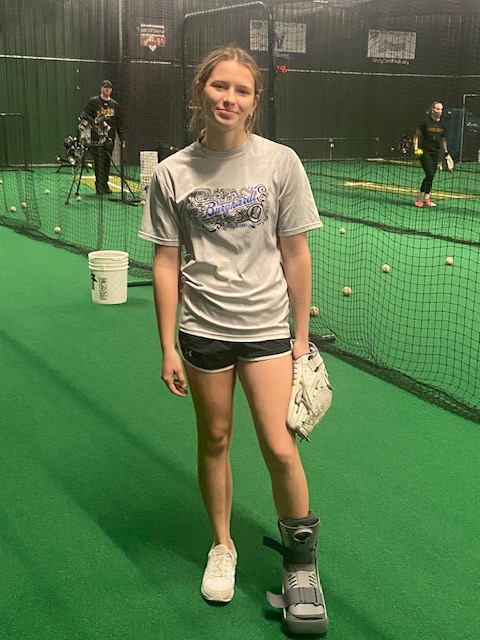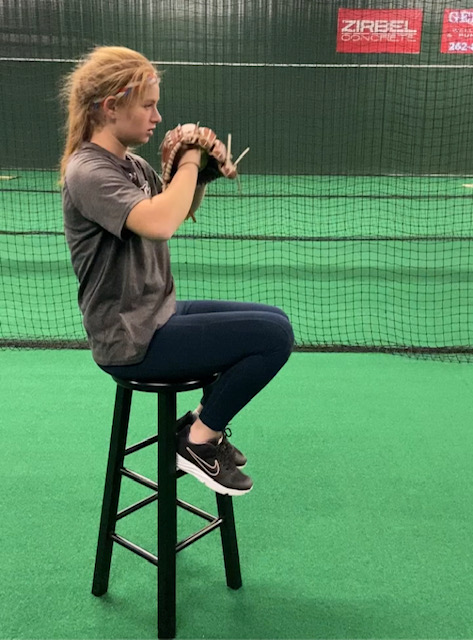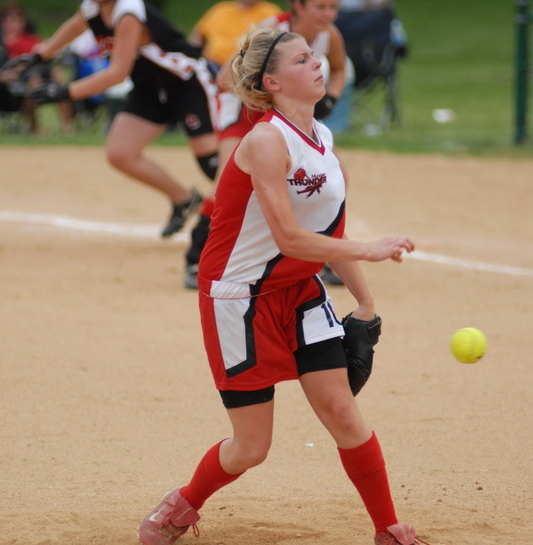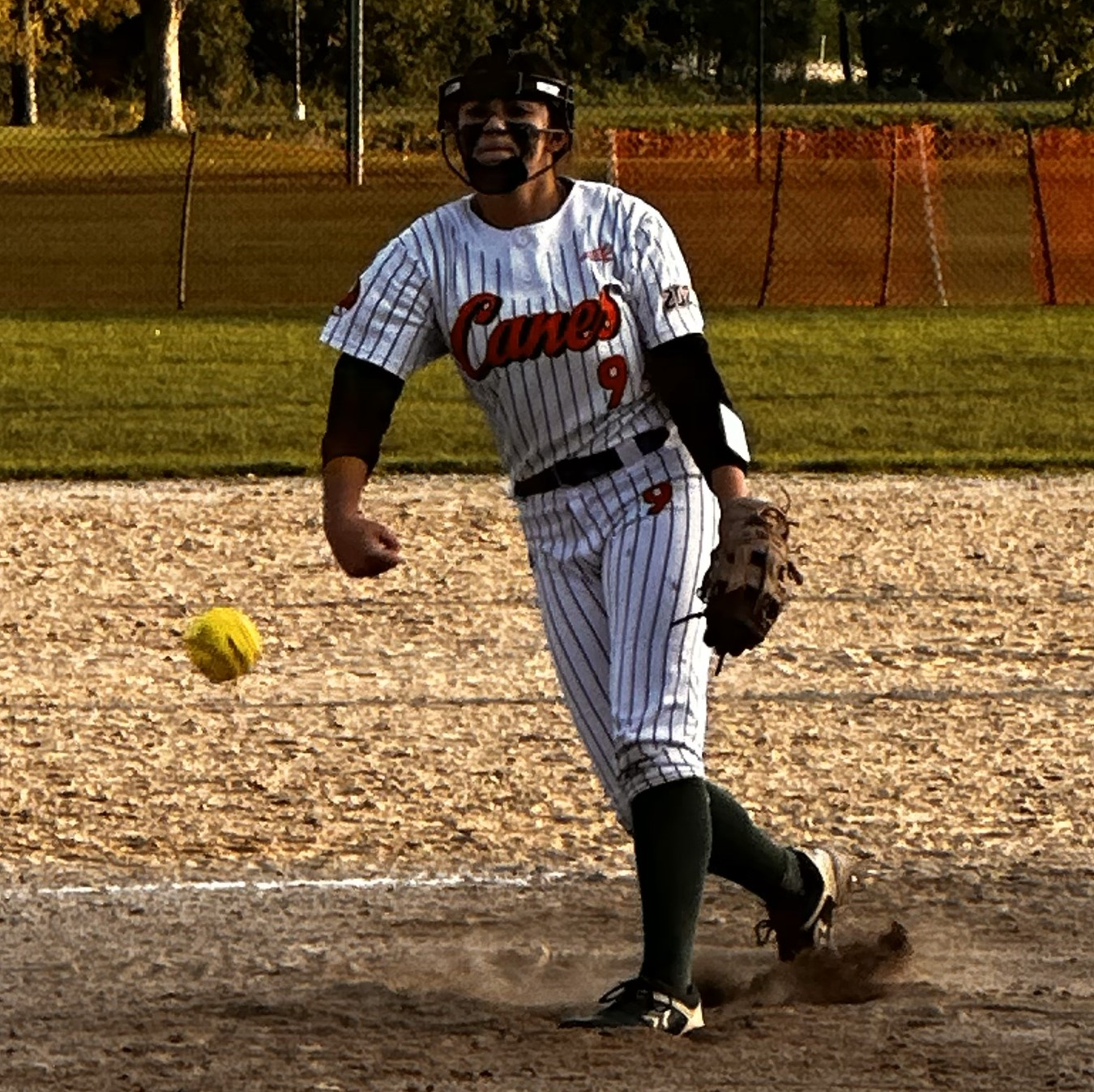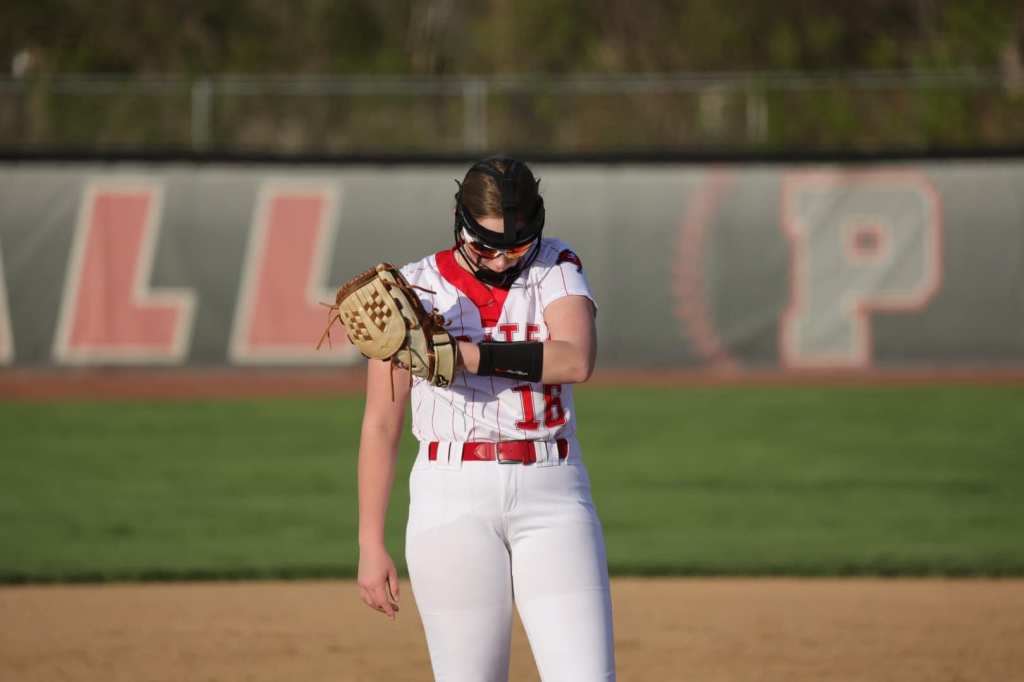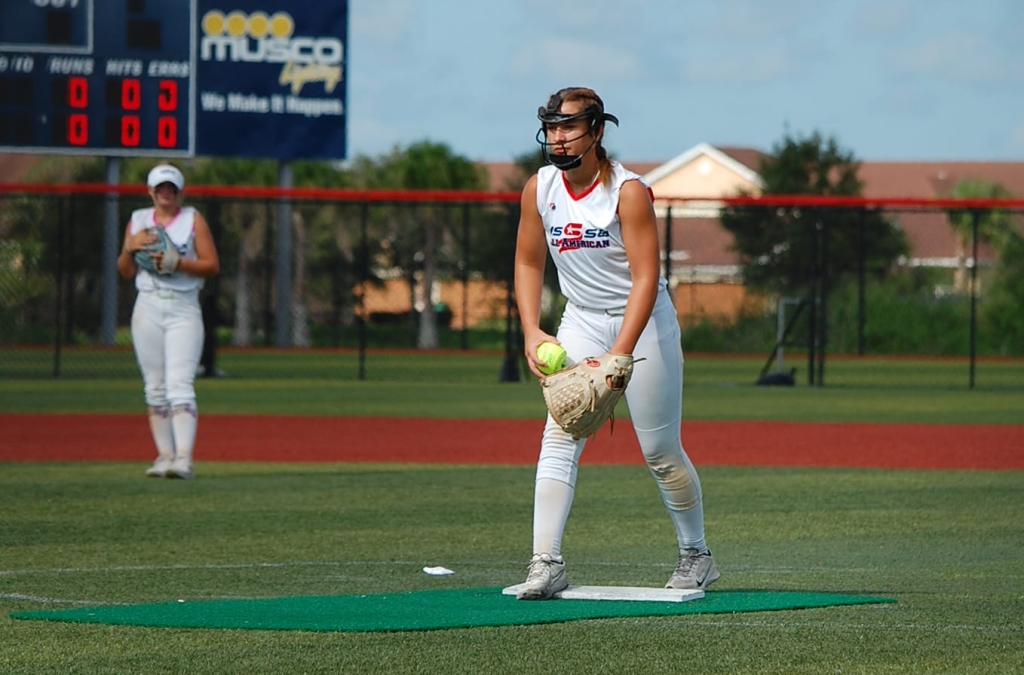Author Archives: Ken Krause
Fastpitch Pitching Advice from Taylor Swift

This week’s topic goes hand-in-hand with last week’s blog post about the art of pitch calling. If you haven’t read that one yet I suggest you do; it’s brilliant.
All too often these days it seems like fastpitch pitchers are treated like a vending machine. Someone puts a pitch call in and pitchers are expected to spit it out with zero thought involved.
To me, and I think to most pitching coaches (PCs chime in here in the comments) that is absolutely the wrong approach. Instead, pitchers need to be playing along in their heads, thinking about what that hitter looks like, what’s worked on her in the past (if she’s faced her before), what pitches are working today (and how well), and what she thinks ought to be the next pitch she throws.
Then, if the pitch call lines up with what she’s thinking (more or less), she throws it. If it doesn’t, she takes the advice of the ubiquitous Ms. Swift to:
I know it can be difficult. Sometimes nigh on impossible if the pitcher has a coach who believes in his/her own omniscience when it comes to pitch calling, whether that opinion is justified of not.
But if the opportunity is there the pitcher really ought to be the final deciding factor on which pitch gets thrown next. Just like a pilot is the ultimate decision-maker when the plane is in the air.
After all, it’s the pitcher who is going to have to live with the consequences of her pitch.
Of course, in order to do that effectively someone has to train the pitcher on how to set up a hitter and keep her off balance. In other words, how to make decisions on which pitches work best in which situations.
I like to do this during lessons. Team coaches can do it during bullpens. Here’s how.
Select a type of hitter and a situation. For example, no one on, no one out, left slapper leading off.
Then ask the pitcher which pitch she wants to throw. If she’s not sure where to start, guide her with some parameters such as whether the slapper is experienced or a newly converted righty, whether she runs toward the pitcher or toward first base as she comes out, if she stands tall or squats down, how good the defense is behind her, etc.
You can also give some general hints, such as slapping is about timing and slapper are usually trying to put the ball on the ground between shortstop and third. All of that will factor into which pitch to throw.
The pitcher then makes the call. If it’s a good one, she throws it and the outcome (ball or strike) leads into the next pitch call. If the pitch decision isn’t so good, the coach talks it through with the pitcher a little more to help guide her.
With some regular training the pitcher can become smarter, and thus an active participant in the pitch calling decision rather than just a robot programmed to follow directions.
I understand that it’s difficult for a player to feel confident enough in her own decisions to try to overrule a coach by shaking off a pitch. Doubly if the coach is a parent or teacher or just someone who has a more authoritarian approach to their coaching.
But it’s a skill worth learning. And not just for softball.
There’s a pretty good chance that at some point in her life, that pitcher will face a non-softball decision that involves some risk, or perhaps even a moral dilemma. The easy thing to do will be to just follow along with whatever the person in charge says.
But the easy thing isn’t always the right thing. Gaining experience in being part of the decision process, and standing up for herself when she feels strongly another way, will help her avoid much more serious issues later in life than whether a particular hitter got on base in that at bat.
Again, I know it isn’t easy. But it’s worth learning.
Knowing when to shake off a pitch call, and having the confidence to actually do it, is an important of growing as a player, and growing up.
Don’t just be a pitching vending machine. When pitchers become an active part of the pitch calling decision they’ll find they have more success – and more fun.
Vending machine photo by Jenna Hamra on Pexels.com
The Art of Pitch Calling

Whenever a group of fastpitch softball fanatics gets together to talk about pitching, they (we) often talk about the three S’s – speed, spin, spot. You need a healthy dose of all three to be successful, especially at the higher levels.
Within that, however, there is one significant caveat.
Success with speed and spin is almost entirely pitcher-driven. In other words, when you get into a game the pitcher takes whatever skill she has acquired in these areas and applies it to the best of her ability.
Spot, however, is a little different, because often the pitcher doesn’t really have a choice in which spot she is throwing to. She may want to (or prefer to) throw high and inside in a particular situation, for example, but if whoever is calling the pitches wants it low and out that’s where she’s expected to throw it.
That’s what makes pitching calling such an art. No matter how great the pitcher is at hitting her spots, that alone isn’t enough. The pitch caller also has to be smart enough or experienced enough to call the right pitch in each situation or all that spot-hitting ability is essentially neutralized. Or even detrimental.
So how do you go about calling pitches? That really depends on the level of play and the ability of the pitch caller to determine what will work based on all the available information.
For example, in the P5 conferences, and I’m assuming many other collegiate programs, the team has a wealth of data on each hitter and what her tendencies are. Especially for long-term players. There’s a lot of data science in it.
They know what pitches and locations a hitter strikes out on the most and what she pummels over the fence on a regular basis. They know if she’s susceptible to certain locations based on past performance and they know which pitcher threw that particular pitch.
After all, if a hitter has trouble on the inside against a pitcher who throws 70 mph, it doesn’t mean she’ll always have trouble in that location. The more varying the data is, and the more of it you have, the better chance you have of making a good decision.
That, incidentally, is why some freshmen or newly elevated-to-starter-status players will start out hot and then cool as the season wears on. At first there isn’t much reliable data about them, but eventually it starts to accumulate.
But what if you don’t have the luxury of well-populated spray charts and other data? That’s where it becomes more of an art form.
There are some charts out there (like this one) that offer some guidance based on things you can observe. Most of them are based on common sense, such as if a hitter is crowding the plate try to jam her inside with your fastest pitch.
Again, however, it’s not quite that formulaic. It could be that this particular hitter is crowding the plate because she is awesome at hitting inside pitches and not so good at hitting outside pitches.
You try to smoke her inside and she’s going to turn on the ball and launch a very long, dispiriting home run.
That’s why it’s important to develop a feel for pitch calling rather than simply relying on charts or conventional wisdom or other things from the past. You need to be able to look at a hitter and see what she’s bringing to the plate that day.
Another important skill is learning how to set the hitter up for the outcome you want. For example, if she awkwardly swings at a low outside pitch for strike one, she just showed you she’s probably not comfortable out there.
Try another one a little further off the plate. If that induces strike two, see if you can get her to swing at a curveball off the plate.
If she doesn’t bite, you can try coming inside, then going back outside again if necessary. The idea is to make sure she never gets totally comfortable with what she’s seeing.
Another good strategy is if the hitter fouls a ball straight back on a speed pitch (fastball or drop ball), come back at her with a changeup. If you make her look bad with that she’ll probably figure you’re coming in for the kill with a speed pitch again so maybe throw her another change that falls off as it reaches the plate.
The possibilities are endless. The key is to see where she looks least comfortable and use that information to keep her off-balance and uncertain.
One other key piece of information when you’re calling pitches is to never throw more strikes than you have to. What does that mean?
When you get two strikes on a hitter it’s tempting to try to just put her away right then and there by overpowering her, especially at the younger ages. But unless the other team’s hitters are completely over-matched by your pitcher, that’s a bad idea.
They’ve already had an up-close and personal look at two pitches. If the hitter is any good at all she is starting to figure out your pitcher a little more.
Instead, throw a ball that looks like a strike. It could be a drop or curve or rise that starts in the zone but gets out of it by the time it reaches the plate.
It could be a fastball that’s a ball’s width too high or too wide to be hit effectively. It could be a dying quail of a changeup that starts out thigh-high and then hits the plate or the dirt in front of it.
Just don’t give them anything too good to hit. Work the edges, throw off the hitter’s rhythm, or do something else to make sure she can’t take her best swing at the ball and you’re likely to achieve much better results.
While there is science to pitch calling, at the end of the day it’s still more of an art. And like any art, some people have a knack for it and others don’t.
If you find you’re a don’t-have, find someone else on the team who does have it – an assistant coach, a catcher, even another pitcher – and let them do it. If there are no other options talk to people you know who are good at it to learn their thought processes as to why they call the pitches they do.
That way when you call a spot you’ll not only expect your pitcher to hit it. You’ll be confident it’s a spot worth hitting.
The Best Make Time. The Rest Make Excuses.
As I’m sure you already know, we are at a very busy time of the year.
The school year is almost over, so teachers are diligently working to cram everything they were require to teach but haven’t so far into these last few weeks before the final bell rings for the summer. School, park district, and private organizations are preparing to put on their spring plays/musical recitals or concerts, dance recitals, science fairs, art fairs, and other events.
On top of which rec leagues are launching, travel teams are gearing up for the long summer, and many high schools and colleges are getting ready for their playoffs.
With so much going on it’s understandable that fastpitch softball players might say, “I just don’t have the time” when it comes to the extra work required to help them level up their play. And in many respects they’re right.
But here’s the reality: if leveling up is important to you, somehow you will make the time. If it’s really not, you’ll make excuses.
Take the photo of Madi shown here for example. She has one of the best built-in excuses for not practicing you could have: her left foot is in a boot due to a broken toe.
But instead of saying, “Oh well, if I can’t pitch full-out I can’t pitch” she kept every lesson and worked on what she WAS able to do to help herself get better.
Or how about this Maddy? She could barely walk in the door under her own power due to nerve damage in her leg from taking a couple of hard line drives to the same spot in her shin.
Did she let that stop her? No! We pulled up a stool and she worked on what she could so that when she was able to walk normally again she’d be better than she was before the injuries.
Those are a couple of extreme examples for sure. And their issue was injury, not time-based, so maybe you don’t think it’s quite the same.
The mindset is the same, however, i.e., I’m not going to let anything stop me from getting better.
If your issue is not enough time, then perhaps it’s time to put on your thinking cap and get creative.
One way to do that is to look for short opportunities instead of thinking practice has to be a half hour or an hour. For example, if you have a lot of homework, research shows that taking breaks of 5 to 60 minutes helps keep your mind fresh so you learn better.
Instead of hopping on social media (which doesn’t give your mind the proper break anyway) why not take some practice swings or throw a rolled up pair of socks into a mirror for 10 minutes? The physical activity will help rejuvenate your brain while also helping you improve your softball skills. Three breaks like that and you’ve put in 30 minutes without even thinking about it (pun intended).
Or let’s say your high school team’s practice doesn’t allot enough (or any) time for you to practice a specific skill. When practice is over, hang out a little longer while you’re still warmed up and in softball mode to do a few reps of whatever you need to work on.
What if you’re in the school play? I did those when I was young and I know how much standing around time there is during rehearsals, especially if you’re not the lead.
Go find a corner somewhere and go through whatever mechanics you need to work on, or your band work or other exercises. In most cases you don’t need much more than about a 10′ x 10′ area, or a convenient hallway.
You can even get a little practice time in when you’re standing in line for the school cafeteria or the grocery store with your parents. If you’re a pitcher, work on getting faster, looser pronation at the finish. If you’re a hitter, work on using your hips more effectively.
There are lots of fairly subtle things you can do to make use of the fact that you’re not doing anything else. Sure, people might stare at your funny. But those stares will turn into looks of admiration when you’re out-performing your opponents on the softball field.
The key is to think about practice not in the traditional large block of time way but in smaller bites that you can execute whenever you have a few minutes, or need a few minutes to yourself. Know specifically what you need to work on most, and then make the time to work on it.
All those little on-the-fly practice sessions will quickly add up to the types of big improvements that will help you achieve your goals.
Don’t talk yourself out of greatness. Remember that the best make time and the rest make excuses. Choose which group you want to be a part of.
Changeups Work Better When You Call Them
Ask anyone who knows a thing or two about fastpitch softball pitching about the changeup and they’ll tell you it’s one of the greatest weapons a pitcher can have in her arsenal. The ability to take 10-15 mph off the speed of a pitch while making it look like it will be delivered at the pitcher’s top speed works at every level, from rec ball to college to international play.
Here’s the thing, though. Just like a $500 bat works better when you swing it than when you stand there watching pitches go by, the changeup is far more effective when you throw it.
Now, that may seem obvious but from what I hear from frustrated pitchers, parents, and pitching coaches across the country apparently it’s not. For whatever reason, it seems like when many or most coaches are calling games they prefer to try to blow the ball by the hitter with every pitch rather than mixing in changeups and offspeeds.
Even when the pitcher is clearly not capable of blowing the ball by every hitter on the opposing team.
Personally, I don’t get it. One of the fundamental tenets of pitching is that hitting is about timing and pitching is about upsetting timing.
What better way to upset timing than to throw a pitch that looks like it will be fast but actually comes out slow? Not only do you get to make the hitter look silly on that pitch, you’ve now planted the idea that she can’t just sit on the speed and hit it (because she doesn’t want to look silly again), which means you’re now living rent-free in her head.
I think in some cases one reason coaches will shy away from the changeup is they try one and the pitcher either throws it toward the sky or rolls it in. They’ll then make the decision it isn’t working so won’t call it again.
That’s crazy though. Does that mean if a pitcher throws a fastball in the dirt or into the backstop they won’t call the fastball anymore?
Of course not.
So why shy away from a great pitch when the first one doesn’t work? Try a few, and if it’s still not working then table it for that game and come back to it another time.
Now, I will admit that some fortunate coaches may have a pitcher who actually can blow the ball by all the hitters on opposing teams so they may feel that pitcher doesn’t need to throw a changeup in games. After all, she’s already successful without it.
But that’s short-term thinking. Because if the pitcher really is that good, and wants to continue playing at higher levels, she’s going to eventually find that speed alone no longer gets the job done.
And if she finds that out in college (as some do every year) she’s then going to be scrambling to try to learn to throw a pitch that she should have been throwing regularly since she first learned how to spot that fastball. It could make for a very rough season.
A good changeup has the opposite effect of a pitching machine. The reason most hitters find it tough to hit off a machine (at least at first) is that the speed of the arm feeding the ball doesn’t match the speed of the pitch coming out.
In other words, the arm moves slowly to put the ball in the feeder, but then the ball comes out at whatever high speed it’s set at. The visual cue of the arm doesn’t match the speed of the pitch and thus the hitter has trouble figuring out when to swing.
A great changeup gets the same effect in the opposite way. The visual cue of a well-thrown changeup makes it look like it will come at the pitcher’s top speed, but then the ball comes out 10-15 mph slower.
By the time the hitter’s brain has processed what’s happening she has either already swung or was frozen in place by the incongruity of what she saw, and doesn’t recover until after the umpire has called the pitch a strike.
None of that goodness can happen, however, unless someone actually calls for the changeup.
My recommendation on how to use the changeup is the same as the instructions for how to vote in Chicago: early and often.
Show it early so the hitters know it’s a possibility, meaning they shouldn’t get too comfortable. Even if it doesn’t work the first time it may just set the hitter up for the next speed pitch, i.e., it will make the fast pitch look faster.
Use it often to keep the hitters off-balance. Again, even if it’s not actually working the best.
Force the hitters to learn to have to lay off of it and maybe you’ll get a few more called strikes on other pitches as hitters and coaches try to guess when it’s coming. A little confusion at the plate goes a long way.
Finally, use it regularly to help your pitchers learn to throw it more reliably in games. Many coaches and programs talk about “developing players.”
Here’s a chance to put your money where your mouth is, metaphorically speaking. Help your pitchers become more effective in the long term by developing their changeups, even if it costs you a win now and then, and you’ll have fulfilled that part of your mission.
It’s easy to think of the changeup as being a “beginner pitch” because it’s usually the second pitch a pitcher learns. And because movement pitches such as drops, rises, curves, etc. seem more impressive.
But the reality is a pitcher who is changing speeds effectively, and at will, without tipping the pitch, is going to be awfully tough to hit at any level. Start calling the change more often and you just might be pleasantly surprised at the results it delivers for your pitcher – and your team.
Character Matters for Coaches Too

We often hear about how fastpitch softball players need to be good teammates and people of good character. Coaches will talk about what they look for during tryouts and recruiting beyond skills, and how they need to be able to hold their players to high standards.
But what about the coaches themselves? Shouldn’t being a person of good character matter for them as well?
What brings up this topic is an article my friend Jay Bolden of BeBold Fastpitch, who is a tremendous pitching coach by the way, passed along the other day. It’s one of several great things Jay has shared lately, so if you’re not following him on Facebook you really should.
The article was about a head coach at a D1 college who was recently arrested for shoplifting and possession of a controlled substance without a prescription. What’s really sad is the shoplifting amounted to less than $70, and she only had a couple of the pills in her possession.
Not the amount matters that much for our purposes – right is right and wrong is wrong no matter the scope – but if you’re going to get caught committing an alleged crime that could cost you your job you would think it would be for an amount that would have people say, “I get it.”
Regardless, though, the real issue here is one of character and leadership.
There is more to coaching than than teaching skills, making up lineups, and running plays. Especially when we are talking about youth and amateur sports, which includes college.
The measure of a great coach isn’t just wins and losses, although that aspect is definitely important, particularly in the college ranks. It’s also whether the coach is making a positive impact on those players, helping them become better people who are prepared to live their best lives.
That’s hard to do when you yourself are not exhibiting good character. There’s an old proverb that says a fish rots from the head down.
I have definitely seen that to be true, not just in softball or sports but in the business world as well. Poor leadership and questionable ethics will lead others in the organization to follow their own worst instincts, or at least make decisions that may not be in anyone’s best interests.
Another example of poor leadership is shifting blame to players for poor performance to cover the fact that the coach really doesn’t know what he or she is doing.
I recently heard about a coach complaining that her team wasn’t hitting the ball well enough and wasn’t scoring enough runs. Rather than try to help them solve the root issue(s), however, the coach merely said, “You guys need to hit better. Figure it out.”
How is that helpful? It’s not. It’s just a coach worried that her players’ lack of performance will make HER look bad.
That’s a sign of poor character. Even if the coach doesn’t know what to do technically, she should either bring in someone who does or at least try to bolster her players’ confidence at the plate so they’re not making things worse by tightening up and making poor swing decisions in the hopes that something good will happen (it usually doesn’t).
I think most teams have a code of conduct of some sort that they expect their players to abide by. Coaches should be held to at least that standard, if not a higher one.
Some simple things coaches can do to demonstrate strong character:
- Not smoking, drinking alcohol, or using other substances in the dugout or parking lot, or really anywhere their players are in uniform
- Not playing favorites with certain players; everyone earns their playing time based on merit, even if the coach doesn’t especially like certain players
- Not talking about some players to other players on the team, or to their parents, whether in-person, through direct communication, or on social media
- Not establishing “overly personal” relationships with anyone on the team;
- Enforcing team rules fairly and equally, don’t treat the rules as rules for non-starters and merely suggestions for starters
I remember hearing a great example of this last point being demonstrated several years ago by Mike Candrea, the former head coach at Arizona.
One of his star players broke a team rule a few days before the team was scheduled to play I believe in Regionals. She was seen as critical to the team’s success, and obviously the game they were about to play wasn’t a throw-away game.
Coach Candrea told the player she would not be joining the team on the trip, which may have come as a shock to the player and probably a whole lot of other people. When asked about it he said the rules are the rules, and they apply to everyone.
That had to be hard, especially because if I recall correctly Arizona did end up losing. But Coach Candrea demonstrated to every player on that team that fairness and integrity are (or at least should be) higher priorities than winning, even if the game is “important.”
It takes a lot of character to make that decision. When asked later if he had any regrets about it Coach Candrea emphatically answered, “No.”
That decision set a standard to which we should all aspire. What a tremendous life lesson for his players, and really everyone who has heard that story.
We are all products of our decisions, good and bad. But when you’re a coach you’re not the only one affected by them.
Hopefully whatever drove the coach in the opening story to do what she allegedly did can be overcome with some help and she can make better decisions in the future. But it does create a learning opportunity.
Just as we demand excellence from our players, so must we coaches also set higher expectations for ourselves as well. While it might be tempting to take a shortcut, or cheat a little here or there, or fudge the facts, or pass the blame onto others it’s important to take responsibility and demonstrate the qualities we want our players to exhibit on and off the playing field.
Character matters.
Photo by Anastasiya Gepp on Pexels.com
Little Things That Make a Big Difference
It seems like softball coaches, players, and especially parents are always in search of the “silver bullet” – that one technique or piece of knowledge or magic adjustment that will take an average (or below-average) player and turn her into a superstar.
That desire is actually what keeps a lot of what I would call charlatans – people who claim to have a “secret sauce” when really what they have is a knack for hyping otherwise very ordinary solutions – in business. It’s also what drives some of the incredibly crazy drills or controversial posts you see on social media.
Well, that and a need to constantly feed things into the social media machine so they can keep getting those clicks.
In my experience there is no single silver bullet or secret sauce drill that can turn an average player into a superstar overnight. There is no “next big thing” either.
But there are a lot of little things that can make a huge difference in your game if you learn to execute them properly. Here’s a little collection of some of them.
Pitching a rise ball
The rise ball is often the toughest pitch to learn. That’s because getting true backspin on a 12 inch softball (versus the typical bullet spin) requires the pitcher to do some things that work against the body’s natural tendencies.
One of the biggest has to do with what the hand and forearm do at release.
The natural movement for the hand and forearm as they pass the back leg is to pronate, i.e., turn inward. If you hold your arm up and let it just drop behind you, you’ll see that inward turn when you get to the bottom of the circle.
Try it for yourself, right now. Go ahead, I’ll wait.
When you’re throwing a rise ball, however, you have to keep the hand and forearm in supination, i.e., pointed outward, as you go into release if you want to be able to cut under the ball and achieve backspin. Otherwise you’re throwing a drop ball.
What often happens, however, is that in trying to keep the forearm and hand pointed out, the pitcher will cup her hand under the ball so the palm is pointed toward the sky or ceiling. That may work to impart backspin when doing drills from a short distance away, but it will also create a “big dot” spin instead of a more efficient and active “small dot” spin when thrown full-out.
So, to throw a true backspin rise the pitcher needs to learn to keep the palm of her hand pointed mostly out to the side, with just a slight cupping of the fingers. In other words, throw with more of a fastball-type orientation (fingers down) going into release, then angle the hand back up slightly so the fingertips are under the ball instead of to the side.
Do that and you have a much better chance of getting 6 to 12 backspin. (For those unfamiliar with that term, think of an analog clock, with the spin direction moving from the bottom at 6:00 to the top at 12:00.)
Another key is to freeze the fingers at release rather than trying to twist the ball out like a doorknob.
Again, twisting or “twizzling” the ball (as Rick Pauly calls it) will work when you’re self-spinning or throwing at a short distance. But once you try to put any energy into the ball, your hand’s natural tendency to pronate or turn in (remember that from a few minutes ago?) will cause you to turn the palm forward and create bullet spin.
Now, if you can throw the ball 70 mph or more, I suppose it doesn’t matter how your rise ball is spinning so you can get away with that. But if you’re not, forget the twizzling and make sure your hand simply cuts under the ball like a 9 iron hitting a golf ball onto the green and you’ll have a lot more success with it.
Bend in slightly to the curve ball
The curve ball tends to have the opposite problem. Here, you want your hand to be palm-up (if you’re throwing a cut-under curve) so the spin axis is on top of the ball.
The problem is many pitchers will tend to extend their spines a little as they go to throw the curve, which will naturally make the hand tend to sag down, turning the palm more out and away rather than up.
To avoid that issue, try bending in slightly over your bellybutton (on the sagittal plan for those who love the technical terms). That slight bowing in makes it easier to maintain a palm-up orientation, placing the spin axis on the top of the ball and creating a better chance for the fast, tight spin that enables a late break.
Get hitting power from your hips, not your arms
Look, I get it. You hold your bat in your hands, which are at the ends of your arms. So logically you would think to hit the ball harder you should use your arms more if you want to swing the bat harder.
And yes, that will work if you’re on a tee, where the ball isn’t moving. But if you’re not 7 years old, it won’t work so well when the ball is moving.
The reason is when you use the arms to create power, you give up control of the bat. You’re just yanking it wildly and hoping something good would happen.
The better approach is to use your hips (and core) to generate energy through body rotation. More energy, in fact, than you can create with your arms.
Then use the arms to easily direct that energy toward the ball. Approaching it this way will give you the adjustability you need to take the bat to where the ball is going instead of where it was when you first started the swing.
Generating power from the hips first also gives you more time to see the ball before you have to commit the bat, further allowing you to fine-tune the path of the bat to where the ball will be when it gets close to the plate.
Remember, the difference between a great contact and a weak one, or no contact for that matter, can be measured in centimeters (fractions of an inch for those who don’t remember the metric system from school). The ability to make fine adjustments during the swing is often the difference between a great hit and a poor one. Or none at all.
Shoulder tilt creates bat angle
While we’re talking hitting, another small adjustment has to do with the angle of the shoulders at contact.
We’ve all heard the instruction to “swing level” at some point or another. Many of you may have even said it, or say it now.
But if by swing level you mean having the bat parallel to the ground you’re just asking for a season filled with pop-ups and ground balls.
If you look at great hitters at the point of contact, you’ll see that 99 times out of 100 they have an angle on the bat that slopes down from the handle to the barrel. If you look a little further, you’ll see that the angle of the bat usually matches the angle of the shoulders.
So…if you want to get a great bat angle to hit rising line drives and other powerful hits, you don’t really need to manipulate the bat. You just need to let the back shoulder tilt downwards toward the ball. This preferably happens about halfway through the turn rather than dropping the shoulder first and then turning.
Think of the back shoulder as an aiming device. Once you see where the ball is headed, take the back shoulder in that direction and swing on a plane that matches the shoulder angle.
Before you can say “Bob’s your uncle” (always wanted to use that one) you’re crushing the ball deep – without having to do any crazy manipulations.
A better way to put on your glove or mitt
Given the power of the Internet to spread information I’m surprised that this little trick isn’t more well-known.
When most people put on a softball glove or mitt, they tend to put it on as they do a regular glove, i.e., one finger in each slot. I mean, it makes sense, right?
But that’s now how the pros do it. The problem with the one finger, one slot approach is that you ring and little fingers are your two weakest fingers. Far weaker than the index and middle fingers.
So when you go to catch the ball, your weakest (little) finger is trying to close at least half, if not more, of the glove by itself while the strongest part of your hand is closing the other half. You don’t have to be an anatomy expert to figure out why that can contribute to a lot more dropped or mis-handled balls.
Here’s a trick that can solve that issue: Take your ring and little finger, hold them together, and then slide them into the loop in the last finger stall. Then move each of the other fingers over one toward that end, leaving the area for the first finger open.
Now your two weakest fingers have combined to create one stronger finger, better balancing the closing power between the thumb and other side of your hand. You middle finger also gives somewhat of an assist to the other two.
And bonus, you no longer have to leave your index finger out of the glove to keep it from hurting when the ball hits the palm of the glove because it’s not in that spot anymore!
It’s going to feel awkward at first, especially because your hand won’t go into the glove quite as deeply. But try it for a month. You’ll never go back to the old way.
Little things mean a lot
None of these little tips are earth-shaking or revolutionary. But each of them can make a significant difference in your performance.
If you’re struggling with any of these issues, give these tips a try. It’s amazing the difference a slight adjustment can make.
There’s a Difference Between Being Demanding and Being Mean
We’ve all seen the stereotype in dozens of sports movies over the years: the coach who constantly screams at and demeans his/her players early in the movie only to go on to win the a championship during the climactic ending.
It makes for great Hollywood drama. But unfortunately too many people today watch those movies and think it’s a blueprint for how to become a successful coach.
So all they really do is learn how to yell and scream at their players, calling them names and telling them how horrible they are. And then punishing them physically for a lack of performance.
Do they really think that helps? Personally, I think it’s more of a symptom that the real-life coach has no idea how to help their team better so they just yell or do other things in the hopes that it will miraculously scare the players into playing better.
So does that mean coaches shouldn’t raise their voices to their players or hold them accountable? Absolutely not.
But what they need to understand is there’s a difference between being demanding, or being tough, and being mean.
Being demanding is holding your players to a high standard – after teaching them what the standard is. Take a baserunner who is called out for not tagging up at third.
My first question in that situation is whether the coach actually went over the rules on tagging up and explained what to do in that situation. If not, they shouldn’t be calling out the player.
As a team coach, I always assumed my players didn’t know anything if I didn’t teach it to them. That way I was encouraged to teach them as much as I could about the game rather than assuming they knew certain things only to be disappointed later.
If the coach did teach it and the player had a mental lapse then yes, the coach should call it out. While they may get a bit heated in the moment, a demanding coach will remind the player that they went over it, here’s what you’re supposed to do (teachable moment) and talk about staying focused and aware of the situation.
A mean coach will call the player a name or two, ask if the player is trying to make the coach look bad, and probably bench the player for making a mistake. The problem is, if the player made that mistake she probably doesn’t know what she should have done instead, and the situation is likely to repeat itself in the future.
Demanding coaches are tough because they want to get the best from their players. To paraphrase the old Boy Scout slogan, they want to leave the player better than they found her.
Mean coaches are tough because they feel anything players do wrong reflects poorly on THEM, and their egos can’t handle people thinking they are bad coaches.
Demanding coaches believe in their players and hold them accountable to a defined set of standards. They care about seeing their become better at the sport as well as better people.
Yes, they want to win just like anybody else. But they’re also careful not to sacrifice their players’ self-esteem at the altar of winning.
Deep down they want their players to enjoy the experience and maintain or even enhance their passion for the game. And yes, their overall goal is for their players to have fun.
Mean coaches don’t rally care if their players are enjoying the experience or having fun. They don’t care if their players get burned out or lose their passion for the game because hey, there’s always another player coming along and maybe that one will be naturally better.
Which is a good segue to the fact that demanding coaches love to teach the game to their players. As with our baserunning example above they don’t assume anything; they thrive on the details.
Take the story about UCLA basketball and all-around coaching legend John Wooden. The first thing Coach Wooden would do with his incoming freshmen was teach them how to put on their socks.
Now, these were 18 year old college students who had presumably been dressing themselves for more than a decade, and many at first thought it was silly that their coach was teaching them how to put on socks. But the process served two purposes.
First, the way he had them do it would help prevent them from getting blisters on their feet during the long and difficult practices they went through. Very practical.
But it also served to show them in a subtle way that there was a UCLA way to do things, and that these individual players, all of whom had probably been stars on their high school teams, needed to adopt the UCLA way of doing things if they were going to be part of the team.
I find that mean coaches don’t teach the game that much – often because they haven’t put in the effort to learn much beyond the basics or whatever they were taught when they were playing. They would much rather just try to recruit good players and throw them on the field to fend for themselves.
Then, if their performance doesn’t meet the coach’s standards (i.e., it causes the team to lose), the coach will try to harangue the player into doing better or bench them in the hopes that feeling bad about being taken out will make them play better the next time they’re on the field – if there is a next time.
In the end, it all comes down to intentions.
The demanding coach wants to see players reach their potential not just as athletes but as human beings, and will remind them that the pursuit of excellence has no days off. They may sound mean or angry at times, but underlying that surface is a layer of love.
The mean coach doesn’t really care about the player reaching their potential except as it affects winning and the accolades that the coach will receive for the team’s performance. There is no love there, or loyalty for that matter.
It’s simply a transactional approach that sees players as chess pieces to be used and/or discarded as-needed to bolster the coach’s self-image, regardless of the toll it takes on their players.
The good news is both players and coaches have a choice.
If you’re a coach, think about what you’re doing and why you’re doing it. Is it helping your players to become better people as well as athletes?
If yes, great. If not, while you may think you’re being tough you may just be being mean.
If you’re a player, or the parent of a player, think about whether this coach cares about you as a person and is promoting your love of the game.. If yes, while you may not always enjoy it they’re being demanding to help you grow.
If not, they may just be mean. And you can either accept and understand it for what it is or move on,
Either way it’s not you. It’s them.
Angry woman photo by Andrea Piacquadio on Pexels.com
Developing Fastpitch Pitchers: The Speed v Accuracy Debate
One of the age-old questions when developing fastpitch pitchers is whether coaches should prioritize speed or accuracy.
Of course the real answer is they should focus on mechanics and everything else comes from that. In other words, focus on the process and the outcomes will take care of themselves.
Still, you do need some way of measuring whether the mechanics you’re working on are helping your pitcher get better or not. The two most common are speed and accuracy.
So we again come to that question: which of those should be the priority? In my opinion, the priority for young pitchers should be speed. Here’s why.
Let’s say you choose to prioritize accuracy. Understandable, especially if you are a team coach.
You want pitchers who can get the ball over the plate and get hitters swinging. After all, you can’t defend a walk and all that, and no one likes a walkfest.
The problem is, if you sacrifice speed for accuracy your pitcher will develop a way of pitching that is totally focused on that outcome. That will get her by up until about the age of 12, especially if you’re not playing high-level ball.
But at some point she will need to gain some speed or she won’t be pitching anymore. While it may have been good enough to “just get the ball over the plate” when she was younger and the opponents didn’t hit very well, those hitters have been developing too.
And they can now crush those slow meatballs all the way toward South America.
So she’s going to have to gain some speed. The problem is, that’s going to throw off her whole way of pitching because she’s going to need to use her body differently than she’s been doing it, which means her accuracy will go down anyway. And now she’s neither fast nor accurate.
Let’s look at it from the other side. If you focus on speed first, your pitcher may have some trouble throwing strikes at first.
Young people don’t always have total command of their bodies, and some have less than others. Which means you could have arms and legs (as well as pitches) going everywhere when they try to use their full energy But…
The more they work at it at full or near-full energy level, the better they’ll be able to feel their body moving in space. Pitches that were way wide, or going to the top of the backstop, or rolling in the dirt, start getting closer to being strikes.
The zone keeps narrowing until finally the pitcher can throw reliably. Only instead of throwing meatballs she’s bringing heat.
And as she gets older, the mechanics she developed to build that speed continue to be refined, giving her better and better control without having to go back to the drawing board and re-learn how to pitch.
In the end, it comes down to what your goals for that pitcher are. If all the team coach cares about is not giving up walks to ensure a better shot at wins in the short term, it might make sense to go for accuracy.
Your pitcher will definitely get more opportunity to pitch right now.
If, however, you’re looking to develop your pitcher in a way that delivers long-term success, put the priority on speed and let accuracy come later. Because by the time a pitcher is 13, she needs a minimum level of speed to even be considered for most teams, much less given the ball when it counts.
You show up to a tryout with speed and no one cares how many batters you walked or hit when you were younger. They may even be willing to take a chance on you if you look a little wild.
But show up throwing in the mid-40s or less and you’re probably not going to be pitching much no matter how accurate you are. Because by that time accuracy will be considered table stakes, not a point of differentiation.






